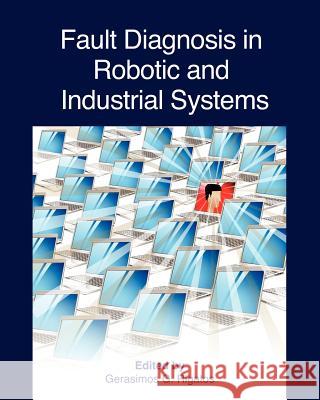Fault Diagnosis in Robotic and Industrial Systems » książka
Fault Diagnosis in Robotic and Industrial Systems
ISBN-13: 9781461098744 / Angielski / Miękka / 2012 / 210 str.
Fault detection and isolation is an important topic for researchers in the area of robotics and for industrial systems engineers. The need for a systematic method that will permit preventive maintenance through the diagnosis of incipient faults is obvious. At the same time it is desirable to reduce the false alarms rate so as to avoid unnecessary and costly interruptions of industrial processes and robotic tasks. The proposed book aims at analyzing recent advances in the area of fault diagnosis for robotic and industrial systems. There are totally 9 chapters in this book. Chapter 1 deals with supervision for the safe navigation of autonomous robots in a natural environment. Fault diagnosis and natural environment perception are used at different levels within a supervisor architecture and real operation is demonstrated on an autonomous tractor driving in an orchard. Chapter 2 gives an introduction to fault tolerant sensor systems which is based on the Failure Modes and Effects Analysis (FMEA) method. Chapter 3 aims at analyzing and implementing new solutions for the problem of distributed estimation for condition monitoring of nonlinear dynamical systems (e.g. automatic ground vehicles, unmanned surface or underwater vessels and unmanned aerial vehicles), so as to enable early detection of faults and the take up of efficient restoration measures. To this end, the development of distributed nonlinear state estimation and distributed fault detection and isolation (FDI) tools is proposed. Chapter 4 proposes so-called logic-dynamic approach for fault diagnosis in industrial systems described by nonlinear dynamic models with non-differentiable nonlinearities. The approach allows solving the problem of fault diagnosis is nonlinear systems using well-known linear methods. In Chapter 5, observer design for nonlinear systems described by a Takagi-Sugeno model with unmeasurable premise variables is proposed. Furthermore, a fault tolerant controller is proposed for such a system in order to preserve some performances of the system by trajectory tracking in faulty situations. Chapter 6 explains and demonstrates the utilization of different nonlinear-dynamics-based procedures for the purposes of structural health monitoring as well as for monitoring of robot joints based on Vibration-based Health Monitoring (VHM) methods In Chapter 7, vibrations picked from spalled defective rolling element bearings is presented. It uses a four stage processing algorithm to detect and diagnose the defective component in rolling element. In Chapter 8, the problem of fault diagnosis with parity equations is considered for nonlinear dynamic systems whose models are taken in the form of ordinary differential equations. The active and passive approaches are involved to achieve the robustness of the diagnostic procedure Finally, Chapter 9 proposes a graphical method for diagnosis of nonlinear systems. The proposed method is based on a 2D signature obtained by measurements projection over some moving time-window. This projection highlights what happens inside the system and enables the diagnosis of abnormal behaviors. This book is suitable for advanced undergraduate students and postgraduate students. It takes a practical approach rather than a conceptual approach. It offers a truly reader-friendly way to get to the subject related to the semantic web, making it the ideal resources for any student who is new to this subject and providing a definitive guide to anyone in this vibrant and evolving discipline. This book is an invaluable companion for students from their first encounter with the subject to more advanced studies, while the high quality artworks are designed to present the key concepts with simplicity, clarity and consistency.
Zawartość książki może nie spełniać oczekiwań – reklamacje nie obejmują treści, która mogła nie być redakcyjnie ani merytorycznie opracowana.











